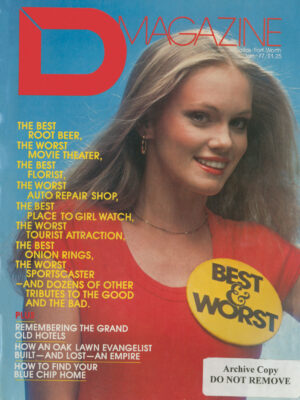Having just returned from a trip to China during which I saw not one Chinese puzzle, I am filled with a noble resolve to rectify the situation. So here is a gift from the inscrutable Orient to the scrutable Southwest.
The simplest kind of code is an inverse alphabet substitution cipher. To generate one, you choose a keyword (of any length) and then write out the remaining unused letters of the alphabet so as to end with two rows of thirteen letters each. For example, suppose the keyword were Oglesby. The cipher would then look like this:
O G L E S B Y A C D F H I
J K M N P Q R T U V W X Z
The cipher equivalent of any letter is the letter lying directly above or beneath it. So in this code Texas would appear as ANHTP. One help in solving an inverse cipher is that a cipher letter and the letter it represents are reciprocal. That is, if you know that P stands for S, then also each S must represent a P. If the keyword has repeated letters, the extra ones must be eliminated so that Merry as a keyword would be MERY and Christmas would be CHRISTMA.
This month’s offering is three Chinese puzzles. Each sentence of a given puzzle is encoded in a different cipher. Note that the last sentence of each puzzle is a question. This question will be answered by a phrase made from the keywords of the ciphers for that puzzle. Thus the solver’s first job is to decode the sentences. Use length and spelling peculiarities of words, their placement, punctuation, etc. to help break each code. Once you have decoded a sentence, you can by deduction set up the cipher like the example above to discover what the keyword was. The solution to a puzzle is not complete until you have answered its question from the keyword phrase.
For those who like extra hints: if your intuition fails you, brute force will sometimes work. The most common letter in English is E (12.3% frequency) followed by T,A,O,N,I,S,R,H in that order. The most common two-letter words, in order of frequency, are of, to, in, it, is, be, as, at, so. The most common three-letter words, in order: the, and, for, was, his, not, but, you, are. Four-letter words: that, with, have, this, will, your, from. One or two more may be added to the last list by those attempting this puzzle.
Send your solution with name and address to Puzzling, D Magazine, 2902 Carlisle, Dallas 75204. All correct solutions will be held for one week after receipt of the first entry, at which time a drawing will take place to determine the winners. First winner will receive a $25 cash prize. Runner-up will receive a free one-year subscription to D Magazine. Winners and completed puzzle will appear in the February issue.
Get our weekly recap
Brings new meaning to the phrase Sunday Funday. No spam, ever.
Related Articles

Arts & Entertainment
Finding The Church: New Documentary Dives Into the Longstanding Lizard Lounge Goth Night
The Church is more than a weekly event, it is a gathering place that attracts attendees from across the globe. A new documentary, premiering this week at DIFF, makes its case.
By Danny Gallagher

Football
The Cowboys Picked a Good Time to Get Back to Shrewd Moves
Day 1 of the NFL Draft contained three decisions that push Dallas forward for the first time all offseason.


